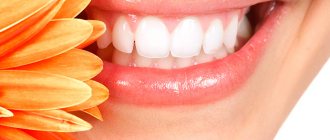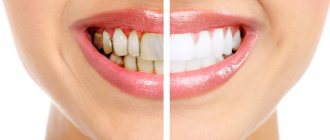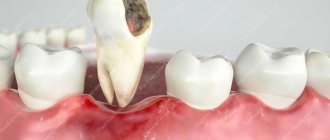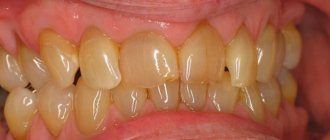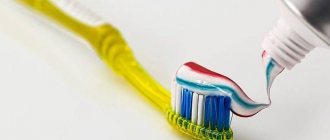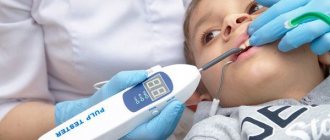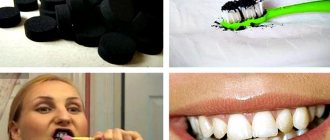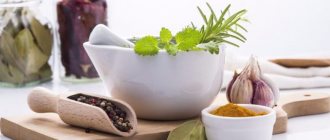From this article you will learn:
- how is tartar formed?
- Is it possible to remove tartar at home,
- which will help reduce the amount of dental plaque.
The article was written by a dentist with more than 19 years of experience.
The ability to remove plaque at home will depend on its type. For example, you can use special products, which we will discuss below, to remove not too massive pigment plaque that occurs in smokers and lovers of too strong tea or coffee. As for removing plaque, using a regular toothbrush and toothpaste only removes soft microbial plaque well. Removing partially mineralized plaque, and especially tartar, requires the use of special means.
With irregular oral hygiene, soft microbial plaque that is not removed from the teeth in time begins to gradually mineralize (absorbing calcium salts from saliva), turning into hard tartar. It will no longer be possible to remove tartar at home if it is completely mineralized or large in size. But if you have a smoker’s pigment plaque, or the microbial plaque is only partially mineralized and therefore has a loose consistency, then for these cases there is one fairly effective method.
Hard dental plaque: photo
Such dental deposits (tartar) as in Fig. 1-3 can only be removed at the dentist by signing up for an ultrasonic teeth cleaning procedure. Only partially mineralized stone, which is small in size and has a loose consistency, can be removed at home - and all this applies only to supragingival dental plaque. Subgingival tartar, which is present in almost all patients with gum disease, can only be removed by a dentist.
So what can replace a visit to the dentist if you have smoker plaque or a small amount of tartar. A combination of an Oral-b electric brush and a special teeth polisher will help us with this. Let us remind you that Oral-b toothbrushes are made on the principle of a dentist’s instrument, which the doctor uses to remove plaque and the remains of hard dental deposits. You will probably remember how, after the ultrasonic cleaning procedure, the doctor polished your teeth with a rotating attachment with bristles and polishing paste. And we will do the same.
So, for this we need:
- electric brush from Oral-b,
- special toothpaste.
Is it possible to remove tartar at home?
In the presence of dense and old deposits, effective removal of tartar at home is almost impossible. The most complex is considered to be subgingival tartar, which forms in periodontal pockets. In this case, contacting a hygienist is mandatory.
Of course, with due effort it is possible to remove the top layer of hard supragingival deposits, but its complete removal is only possible with the help of special equipment in the dental hygienist’s office. When the plaque is in the initial stage of hardening or has a loose structure, it can be quite successfully dealt with at home. It’s easier to do prevention than to deal with the consequences.
Basic concepts, localization sites, etiology and signs
Tartar consists of a layer of calcium, phosphate and iron salts, food debris, dead cells and bacteria
One of the most common dental problems with which patients turn to doctors is the presence of tartar.
This is a pathological dense deposit on the surface of the teeth.
It consists of a layer of calcium, phosphate and iron salts, food debris, dead cells and bacteria.
Taking into account the location of dental stones, they are classified into:
- Supragingival. They form on the front teeth on the inside of the lower jaw or on the outside of large molars. May also appear on dentures.
- Subgingival. They are localized in the periodontal pockets of any tooth. They are characterized by a dark color and increased hardness.
The main reasons for the appearance of such deposits include:
- Insufficient hygiene
- Unbalanced diet
- Changes in the structure and properties of saliva
- Development of cervical caries
- Curvature of the dentition
- Hereditary predisposition
- Immune system diseases
- Chronic foci of infection
- Systematic smoking
- Periodontal inflammation
In addition to the visual manifestation, large dental stones can manifest themselves in the form of the following signs:
- Pain when eating food
- Hypersensitivity of the external protective shell of the coronal part of the teeth
- Periodontal bleeding
- Excessive congestion of blood vessels and swelling of the gums
- Manifestations of unpleasant odor from the mouth
- Mechanical damage to the tongue due to mineralized deposits
Important! If you experience the slightest signs of tartar development, you must urgently seek qualified help from specialists. Ignoring treatment for this pathology can lead to serious dental complications.
How to remove tartar at home?
No matter how trivial it may sound, cleaning tartar at home is carried out with ordinary hygiene products: toothpaste, brush and irrigator.
- Toothpaste. For more or less effective removal of tartar, you need high-quality toothpaste with high abrasiveness (with an RDA coefficient of 120). Such products contain solid microparticles, most often silicon dioxide or aluminum oxide. Abrasive toothpastes do a good job of removing loose plaque and are even able to clean loose hard deposits, but at the same time they cause damage to the enamel. They are not suitable for people with sensitive teeth. This is especially true for tooth powder, which often appears in lists of tips on how to get rid of tartar at home. It should be used with extreme caution as it contains a large number of aggressive abrasive elements.
- Toothbrush. To quickly remove tartar at home, while its layer has not yet become thick, you need to use a toothbrush with the hardest bristles. This option is not suitable for everyone, since intensive cleaning causes the bristles to injure the enamel and gums. A good ultrasonic toothbrush would be ideal.
- Irrigator. A jet of water (even at high intensity) is not capable of destroying hard tartar, but it does a very good job of removing loose plaque. An irrigator is strictly recommended if you want to get rid of tartar at home, since it effectively cleans the most inaccessible areas of the oral cavity.
Products that should never be used -
Before writing this article, I carefully studied various sites that write on the topic of removing dental plaque at home. As a practicing dentist, I was somewhat shocked that such articles (by all indications) were written not just by “NON-dentists”, but by people who have absolutely nothing to do with medicine, and sometimes even lack common sense and have no idea , and what exactly do they advise.
I bring to your attention a couple of recipes that you can use to remove tartar at home. After the text of each recipe, you can read its analysis - both from the point of view of medical knowledge and a school chemistry course.
Recipe No. 1 –
“You need to make an elixir from grated black radish and lemon juice. This elixir should be consumed before bed, as well as moistened with a toothbrush and brushed your teeth.”
So, comments: the radish and lemon elixir contains nothing more than acid. Previously, in dentistry (when ultrasound was not yet used to remove dental plaque), in fact, before removing dental plaque with hand instruments, strong acids were sometimes used to slightly soften the tartar. Moreover, even after partial softening with acid, it will be impossible to remove tartar with a toothbrush or household tools.
The use of acid for removing tartar was abandoned about 40 years ago for the following reasons: 1) due to the low effectiveness of this method, 2) acid washes calcium from the surface layer of enamel, contributing to its abrasion and the development of increased sensitivity to thermal irritants.
Recipe No. 2 –
“Nut broth.
It is made by boiling 35 grams of walnut branch bark for 20 minutes in about one glass of water. Next, you need to dip your toothbrush in the broth and brush your teeth for 4-5 minutes, 3 times a day.” Comments: Try moistening your toothbrush with water and brushing your teeth with it. The effect will be exactly the same.
- Firstly, you will immediately feel how poorly your teeth are cleaned of plaque if you replace toothpaste with nut broth. Accordingly, this will lead to an increase in the amount of plaque on the teeth and accelerated formation of tartar.
- Secondly, hard dental deposits (tartar) are mineralized soft plaque.
Those. they are formed from soft microbial plaque, which was not cleaned from the teeth in time, and which was saturated with calcium and phosphorus salts contained in saliva. Thus, hard plaque is a very dense formation mineralized with calcium. From the chemistry course, you can remember that in order to dissolve calcium salts, you need a very strong acid, and not a decoction of walnut bark, which has no acidity. And as for the general use of acid to remove tartar, we have already talked about this above, i.e. this is not worth using.
Lemon, celandine and soda
On the Internet you can find many articles with headings from the series “how to clean tartar at home” or “how to dissolve tartar at home.” In these materials you can find dozens of “one hundred percent” recipes that will miraculously help get rid of tartar. In fact, all this is a myth. No traditional medicine can effectively remove hard dental plaque. Moreover, most of these tinctures and decoctions can also cause harm. For example, a decoction of celandine (often recommended) is poisonous and can cause poisoning. Lemon juice, which is a component of most of these recipes, contains acid, which is generally harmful to dental tissue and is ineffective at removing hard deposits.
To summarize, there is more harm from such recipes than good. The only more or less effective remedy, whose chemical properties help to somehow break down small dental deposits, is a solution of soda and hydrogen peroxide. At the same time, the same peroxide (especially if you make a mistake with the proportions) can cause serious harm to the enamel, so you can use it only at your own peril and risk.
How does soda work?
Soda powder has a fine-grained structure, due to which it gently cleanses and destroys tartar. Thanks to its alkaline effect, sodium bicarbonate changes the chemical nature of solid deposits, and due to its abrasive properties, it removes them layer by layer.
On a note. Some professional dental cleaning powders contain from 20 to 50% baking soda.
In addition, sodium bicarbonate improves the condition of the oral cavity:
- Increases the pH of saliva, neutralizing the aggressive effects of organic acids on teeth.
- Gently polishes the enamel, giving it a lighter tone.
- Prevents the formation of plaque, which increases the absorption of minerals from saliva by dental tissue.
Prevention of tartar
This article is entirely devoted to how to remove tartar at home, but it is also important to talk about how to prevent its occurrence. Prevention of dental plaque includes comprehensive and regular oral hygiene. Tartar builds up in hard-to-reach places, so use floss, irrigators and mouth rinses if you want to minimize the risk of plaque mineralization. Another important point is nutrition. Foods high in carbohydrates and dyes accelerate the formation of tartar. The same applies to tobacco: do you want to have healthy and snow-white teeth? Stop smoking. Well, if you do notice the first signs of tartar formation, consult a doctor. Professional cleaning and saturation of the enamel with useful minerals will restore your snow-white smile.
Why does tartar form on teeth?
There is always a certain amount of bacteria present in the oral cavity. This is fine. Moreover, bacteria help in digestion by starting the process of decomposition of food already during chewing.
Bacteria are found on the surface of all oral tissues, including teeth. The latter are protected from the harmful effects of microorganisms by enamel. Bacteria cannot penetrate through it.
But, nevertheless, nothing prevents bacteria from accumulating on the surface of the enamel. This biofilm is easily removed with everyday hygiene - brushing, flossing and irrigating. But in some cases - for example, due to untimely removal - the plaque begins to thicken. The reasons for this are:
- Excessive consumption of sweet foods, sugar, foods high in carbohydrates. All this creates a breeding ground for microorganisms;
- Use of low-quality hygiene products, untimely cleaning;
- Smoking. Tobacco smoke destroys the structure of the enamel, forming roughness, cavities and cavities on its surface;
- Irregularity of the dentition, malocclusion;
- Diseases of the digestive system, hereditary predisposition.
Bacterial plaque is easily removed. However, at some point it begins to petrify – that is, to become denser and acquire a mineral structure. And turns into tartar.
Tartar can no longer be removed with everyday hygiene products. It cannot be brushed or flossed off, and even a waterpik cannot destroy it. At the same time, bacteria in this colony continue to destroy both the tooth and the soft tissue located next to it. As a result, itching, swelling, bleeding begins, and increased sensitivity appears.
Not recommended:
— An overdose of walnut-based medicines is strictly unacceptable. This will lead to toxicity due to the huge composition of active substances in the form of alkaloids, fatty acids, amino acids. - For the treatment of the pancreas, walnut medicines are unacceptable, but if the stomach hurts, then these medicines are the best remedy. — You can’t take nuts and medicines based on it when you have proctitis, paraproctitis, acute colitis and other forms of diseases associated with the intestines. — There are also allergies to walnuts. Then all forms of walnut medicines are strictly prohibited.
Useful and healing properties of walnuts
All structures of the walnut tree have beneficial properties, many of which are used in medicine. Below is a table of the composition of walnuts and its effects on the body.
| Walnut piece | Components | Description, properties |
| Fetus | Coumarins, phenolic acids, tannins, vitamins, carotene, magnesium, potassium, antioxidants. | Vasodilator, an action that reduces blood pressure. Strengthening the walls of blood vessels, eliminating their fragility. Reducing cholesterol levels, due to which atherosclerosis progresses more slowly. Diuretic effect, with its help toxic substances are eliminated. Improving brain activity, accelerating the conduction of impulses along nerve fibers. Treatment of gastritis, gastric ulcer, respiratory diseases (bronchitis, pneumonia, tuberculosis). |
| Partitions | Flavonoids, quinones, carbohydrates, minerals, polyunsaturated fatty acids, vitamins. | Strengthening the immune system, stabilizing hormonal levels thanks to the polyunsaturated fatty acids contained. Used for diseases of the thyroid gland. |
| Shell | Steroids, alkaloids, tannins, quinones, triterpenoids. | Elimination of allergic reactions on the skin (rash, itching, eczema). Removal of salts from the kidneys. Elimination of radioactive structures from blood and tissues. Teeth whitening. Cosmetological procedures (manufacturing hair removal products, cleansing pores on the face, eliminating purulent acne using a disinfectant). |
| Leaves | Alkoloids, essential oil, carotene, vitamins, carbohydrates. | Improves skin quality, eliminates allergic manifestations (rash, itching, redness). They have a bactericidal effect. |
Reviews
Christina. I really like drinking coffee. Because of this, pigmented plaque appears on the teeth. I started brushing my teeth with dry soda powder every day for 1.5 weeks. The result is positive: the teeth are lightened and the plaque is gone. No sensitivity was evident.
Natalia. I used activated carbon. There is an effect, but it is insignificant. I haven’t observed any negative effects, so I use it sometimes.
Olga. I brushed my teeth with baking soda for 2 weeks in a row. The plaque has partially disappeared, but the stones remain in place, and the enamel is still yellow. I don't recommend it.
Vladimir. After using baking soda with lemon, severe tooth sensitivity appeared. Now I can’t eat anything cold or sour. I don’t recommend it to anyone, it’s better to go to the dentist.
Contraindications
Despite the list of beneficial properties, walnut shells against dental plaque have a number of contraindications .
- Firstly, there is an allergic reaction. Before the procedure of cleansing and rinsing with a decoction or tincture, it is necessary to conduct a small test. Apply a small amount to the skin of the wrist and wait. If no rashes appear on the skin within 30 minutes, you can begin cleaning plaque.
- Secondly, the procedure is prohibited for people suffering from stomatitis. Rinsing will only make the disease worse.
- Thirdly, it is important not to swallow liquid while rinsing. It is not intended for drinking and can cause harm to the gastrointestinal tract.
Preventive measures
These recommendations will serve not just as an addition to therapy, but as the basis for daily oral care:
- Stop drinking alcohol and smoking, or at least significantly reduce it;
- Keep your toothbrush clean; it is advisable to change it every two months;
- Remember to eat solid fruits and vegetables;
- Ideally, if you brush your teeth after every meal, at night - definitely;
- It is also necessary to treat your mouth with an antiseptic before going to bed, this reduces the formation of plaque;
- Don't forget to come for a preventive examination every 6 months.
Causes
Tartar is hardened small food waste and plaque that is not cleaned out of the mouth. They have a color different from the color of tooth enamel - yellow, greenish, brown and even black.
95 percent of mineralized plaque consists of harmful bacteria. Most often it is observed near the ducts of the salivary glands.
The formation of such an unpleasant object may occur due to poor hygiene or the inability to reach certain places in the mouth. The reason may be anatomical features or incorrect selection of a brush for brushing your teeth. The formation of tartar is also influenced by the composition of saliva, the general condition of the body and the food consumed. You may also find it useful: What to do if a filling falls out, types of fillings and service life
Contributes to the formation of tartar:
- coffee;
- alcohol;
- fatty food;
- sweet and carbonated drinks.
Chocolate, contrary to popular belief, even protects against some dental problems.
However, we must take into account that we are talking about real chocolate - that is, bitter, dark, which first contains grated cocoa and only then sugar.
It is important to know that you need to chew food using both sides of your jaw in turn. If one of them works harder, the other may suffer from tartar. Few people know about this.
It is worth choosing not only soft foods as food, but also hard ones, for example, apples and carrots. They help cleanse the oral cavity of impurities, sometimes better than brushes.
Effective recipes
Dry soda
The use of dry powder is considered one of the most aggressive methods of sanitation of the oral cavity using soda. A small amount is applied to the surface of the teeth and rubbed thoroughly.
Attention! When applying sodium bicarbonate in any form to tooth enamel, do not use a toothbrush. It is acceptable to use cotton swabs, gauze swabs and turundas.
Concentrated solution
Add soda in small portions to a small amount of water and mix thoroughly. As soon as the powder stops dissolving, the concentrate is ready. Use the resulting liquid to brush your teeth, then rinse your mouth with clean water.
Using foil
To increase the duration of exposure of the soda to the teeth, use foil. Two strips are made from it, onto which a mixture of soda and toothpaste is placed, after which they are wrapped around the upper and lower row of teeth. These foil mouthguards are left in the mouth for 1 hour, then removed and rinsed with clean water.
This method can be used once a week.
Enrichment of toothpaste
Add a pinch of soda to any toothpaste immediately before brushing your teeth. But for maximum enamel protection, it is better to use a fluoride-containing paste with a fluoride concentration of at least 1400 ppm.
Reference. In this case, using a toothbrush is acceptable, but preferably with soft bristles.
With salt
Soda is mixed with dry salt in a 1:1 ratio and a little water is added until a paste is obtained. Use the prepared mixture to brush your teeth 1–2 times a week until the desired effect is achieved.
With iodine
Dissolve 1 tsp in a glass of warm water. soda and add 1 drop of iodine. Rinse your mouth with this solution after each brushing of your teeth.
With hydrogen peroxide
Attention! Hydrogen peroxide is considered an aggressive solution for teeth and oral cavity. Therefore, the product is used no more than once a month.
A small amount of a 3% solution is mixed with soda to form a thick paste, which is rubbed into the enamel for 2 minutes. Then rinse with water.
Carefully! In case of contact with the gums, a burn of the mucous membrane with lightening of the surface is possible. In such a situation, it is necessary to stop the procedure and rinse off the product with clean water.
With fruit acids
Fruit acids enhance the cleansing effect of soda and also lighten the tone of the enamel. Lemon is best suited for these purposes, but you can use grapefruit and kiwi.
Add a few drops of sour fruit juice to the dry powder and rub the teeth for 1 minute. The procedure is repeated no more than 1–2 times a month.
Remember. The mixture with acids has a very aggressive effect on the teeth; frequent use can damage the enamel.
With strawberry
Strawberries have whitening properties, so they are used not only in cosmetology, but also to lighten tooth enamel.
The pulp of fresh berries is mashed, a pinch of soda is added and the teeth are rubbed. This composition is kept in the mouth for 2-3 minutes.
With activated carbon
An activated carbon tablet is crushed to a powder and mixed with soda 1:1. Dip a toothbrush into the resulting mixture and brush your teeth for 1–2 minutes. After this, rinse your mouth with clean water.
This cleaning is used 1-2 times a week.
Attention! Charcoal can stain dentures, crowns and fillings.


